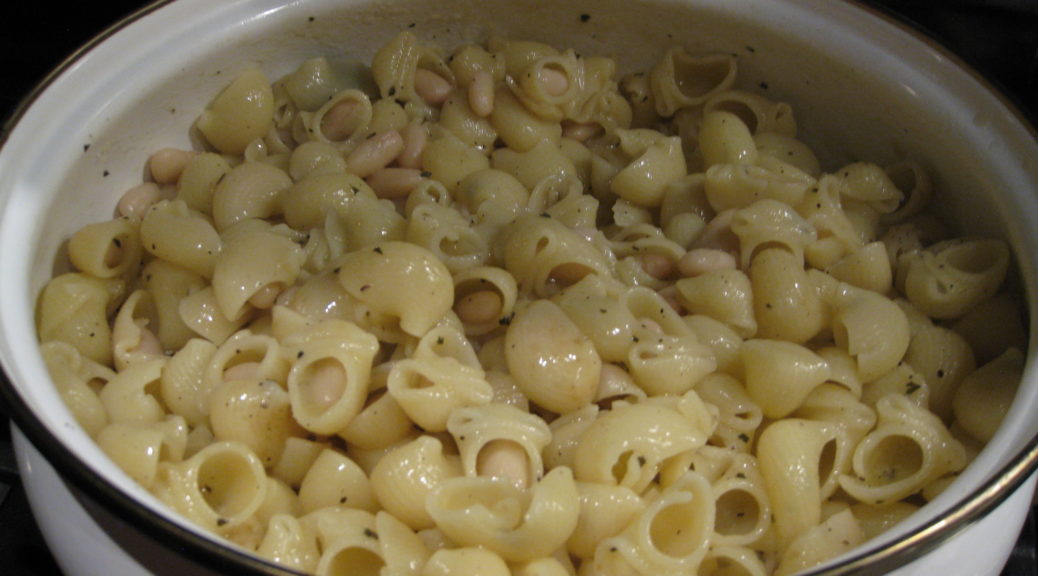January 18, 2017
Talk about comfort food! Pasta e Fagioli (pasta and beans) hits the spot (for me, at least!).
There are endless variations. White kidney beans, red kidney beans, chick peas, butter beans, fava beans, for example. Ditalini, mezzi rigatoni, lumaconi, orecchiette, linguine, and more. Not to mention the possibilities of tomato sauce, anchovies, broccoli, rapini, and escarole. I could go on but you get the point. You could mix and match just those ingredients and come up with hundreds of different combinations.
Growing up, my mother made only one version that I recall. It featured butter beans, tomato sauce and ditalini. The amount of liquid was equivalent to pasta with a red sauce. My Aunt Margie, my mom’s sister, made hers with chick peas and ditalini, no tomato sauce, and it was definitely more of a soup. My guess is that my grandmother made both versions, and probably others, but my mom and my aunt each settled on one for their cooking repertory.
Then there’s a version that I learned from a work colleague, Louis Evangelista, more than thirty years ago. He learned it from his Sicilian grandfather. It features linguine, red kidney beans, escarole, red pepper, and an abundant amount of garlic.
Then there’s orecchiette with kidney beans, broccoli and anchovy.
But we’re not making any of these today. We’re doing a simple version with kidney beans and lumaconi. The others will make their appearance in the coming months.
Lumaconi is a wonderful pasta shape for pasta e fagioli. Lumaconi means snails. Look at the picture below and you’ll see the resemblance. What’s so cool about using lumaconi is that the beans naturally slip inside the cooked pasta for the perfect mouthful of beans and pasta!
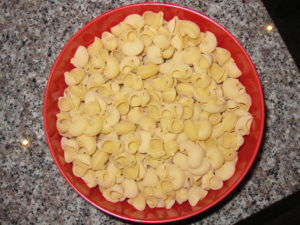
If you use red kidney beans rather than white, the contrast between the bean and pasta will look startlingly like real snails. This might not be a good thing depending on your audience!
I strongly encourage you to start with dry beans rather than canned. Follow the recipe for Cannellini alla Toscana using either white or red kidney beans. For something as hands-off as putting a pot of beans in the oven you’ll be rewarded with enough beans for two, if not three, meals plus a taste profile that is infinitely superior to canned beans.
This last point was hammered home to me a few months ago. We were in Alamogordo with Pat and Becky, friends from Santa Fe. We spent the day at White Sands National Monument sledding down the dunes followed by lunch in Ruidoso before returning to our little house in Alamogordo (the house is another story for another day).




We didn’t feel like going out, not that there are many places to go out to in Alamogordo unless you count Chili’s, which, inexplicably, is my husband’s favorite restaurant in town. Besides, we made the requisite pilgrimage to Chili’s the night before.
So, a couple of cans of kidney beans later, I was making pasta e fagioli. It was good, no doubt. But it had been a very long time since I had used canned beans (even though there is an entire phalanx of canned beans in my pantry). I was actually startled by the difference in taste and texture, having grown so accustomed to using home-cooked beans.
However, by all means, if using canned beans is the difference between trying this dish, and not. Go for it! You might want to throw an extra bit of herbs in the pot at the beginning, like a bay leaf and some sage, but it’s not really essential.
Let me know what you think of the recipe. And for those of you who have your own favorite version of pasta e fagioli, let me know what it is.
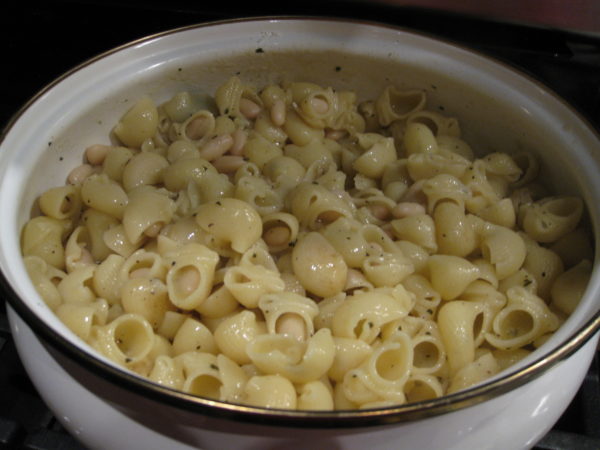
| Prep Time | 15 minutes |
| Cook Time | 40 minutes |
| Servings |
people
|
- 3 cups cooked kidney beans (red or white) plus cooking liquid
- 1/2 cup dry white wine
- 1/4 medium onion finely diced
- 1/2 teaspoon dried basil or 2 teaspoons minced fresh basil
- 1/4 teaspoon crushed red pepper or to taste
- salt to taste
- black pepper to taste freshly ground
- 5 cloves garlic
- 1/3 cup extra virgin olive oil
- 1 pound pasta such as lumaconi, mezzi rigatoni, or ditalini
- 1/2 cup Parmigiano Reggiano cheese freshly grated
Ingredients
|

|
- Combine the beans and their liquid, onion, basil, and red pepper, and freshly ground black pepper to taste in a heavy-bottomed pot large enough to contain the cooked pasta and beans. If the bean cooking liquid and wine does not cover the beans, add water to just cover.
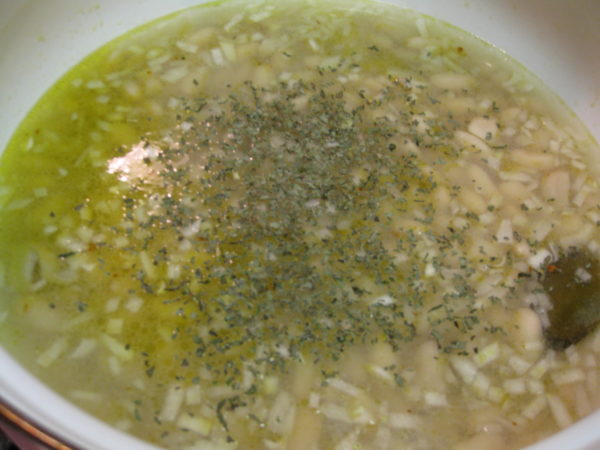
- Simmer, partially covered approximately twenty minutes. Taste for salt after about 10 minutes. Remember that the pasta will be well salted and you will be adding Parmigiano so best not to over-salt at this point.
- Meanwhile, bruise the garlic with the side of a knife.
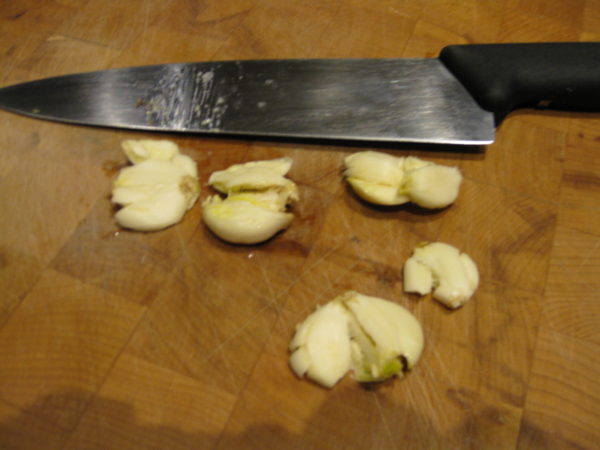
- Sauté the garlic in the olive oil very slowly until browned. Garlic should be quite brown but not burnt which would make it bitter. Remove and discard garlic. Reserve the garlic-flavored oil.
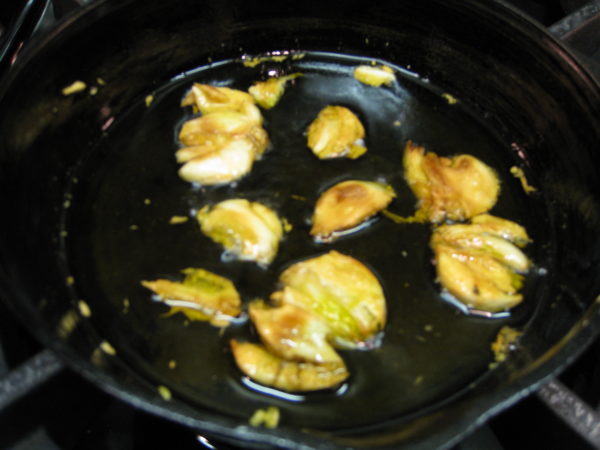
- Cook pasta in 4 quarts of abundantly salted water. The pasta will finish cooking with the beans, so there should still be a small core of hard pasta in the center.
- Just before draining the pasta, scoop out and reserve about two cups of the pasta cooking liquid.
- If you will not be serving the pasta e fagioli in the cooking pot, pour some of the cooking water into the serving bowl to warm it while you finish cooking the pasta and beans.
- Drain the pasta but leave some water clinging. That is, there is no need to shake the colander. Add the pasta to the bean mixture. Stir to combine. Add the garlic oil. Mix well.
- Cover tightly and cook over very low heat for approximately 10-15 minutes stirring occasionally until the pasta is cooked through but still ad dente. Add a little of the reserved pasta water from time to time if needed. When the pasta is finished there should be just enough water remaining to create a sauce.
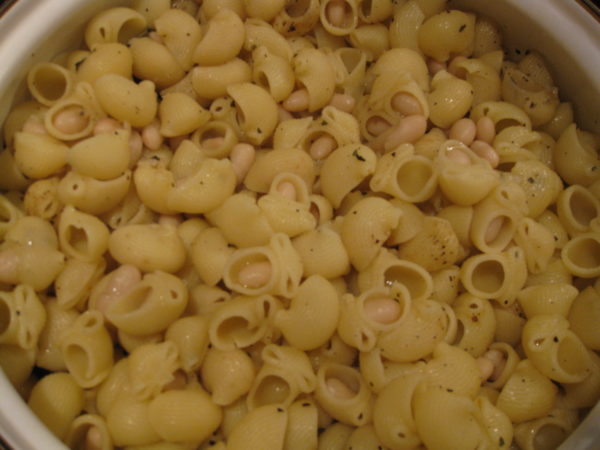
- Off the heat, stir in the Parmigiano Reggiano.
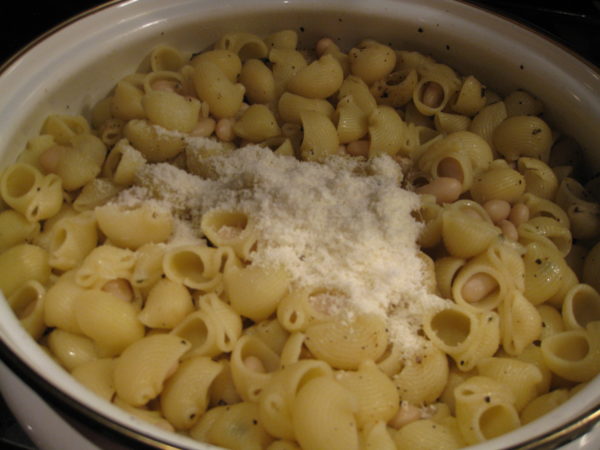
- The combination of the cheese and the starch from both the bean cooking liquid and the pasta cooking liquid should create a glossy sauce.

- You might want to stir in an extra tablespoon or two of extra virgin olive oil both for the flavor and to help emulsify the sauce. Taste and adjust salt and pepper if needed.
- If not serving the pasta in the cooking pot, drain and dry the warmed serving bowl and pour in the pasta.
- Serve the pasta e fagioli with additional freshly grated Parmigiano Reggiano cheese and crushed red pepper.
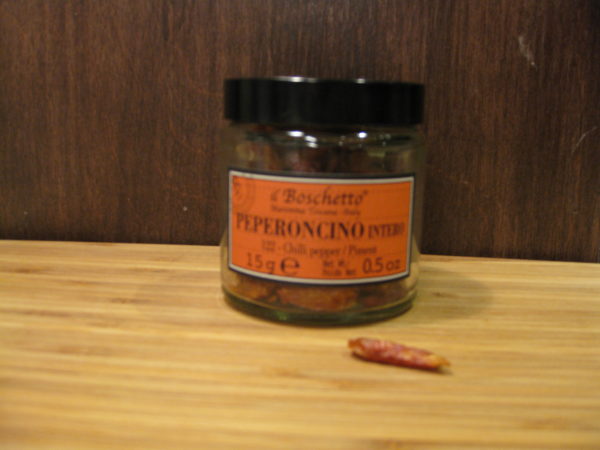
More than other seasonings, quantities of dried red pepper are mere suggestions. Different types of red peppers vary in their heat and flavor profile. Different people have different tolerances for the heat of peppers. If I were making this dish for only myself, I would add at least a teaspoon of crushed red pepper and I’d probably still add more at the table. The suggested ¼ teaspoon is a modest amount that should not cause difficulty, even for individuals with a low tolerance for spiciness. However, make sure that you use one of the more traditional types of crushed red peppers, or even the whole dried Italian peppers that I used in this recipe. Do not make the mistake of using a dried version of one of the super-hot peppers (like bhut jalokia or naga jalokia or even Habanero or Scotch Bonnet) without understanding the heat level they pack!
Copyright © 2017 by VillaSentieri.com. All rights reserved.

